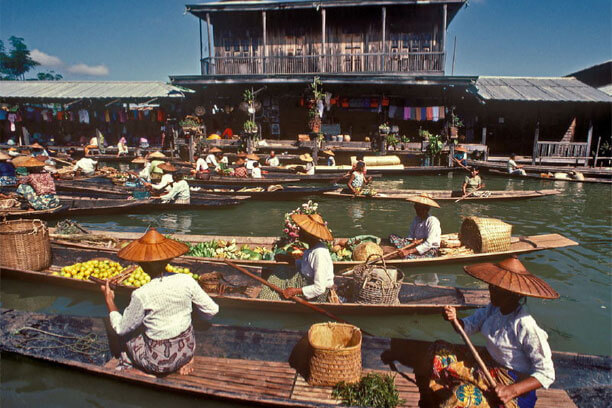
Inlay Lake provides the perfect picture of rural Myanmar lifestyle in perfect harmony with the mesmerising natural beauty of Shan State.
Located in Shan State at the heart of the country, this beautiful highland lake is based at about 900m above sea level, 22km long, 10km across, and is the second largest lake in Myanmar. One of the must-visit places in the country, the lake is surrounded by mountains on all sides offering a breathtaking natural view. The area is rich in animals and plant species and you can see some of the rarest species here.
Inhabited by many different ethnic nationals of the area who follow wellpreserved traditions and cultures, Inlay Lake (also sometimes spelt Innlay and Inle) is famous for the unique way of life of the local tribes, for their villages on stilts, floating gardens, fresh produce markets and well-preserved traditions. There are 17 villages at this lake where the villagers belong to different ethnic groups such as the Intha who are called the people of Inlay Lake, Shan, Taungyo, Pa-Oo, Danu, Kayah, Danaw and Bamar.

In many places the authentic life on the lake shines through. Functioning communities – largely based entirely on the water – are fascinating to observe and interact with. The main source of livelihood is farming and fishing. The area is well known for its locally produced woven textiles especially lotus, and handrolled cheroot cigars. It is also home to plenty of craftsmen who produce handicrafts in time-honoured traditions such as silver wares, bronze wares and wooden sculptures. The same is true of the surrounding villages where, for example, naturally beautiful, handmade Shan paper decorated with fresh flowers. The villagers are famous for a one-legged boat rowing technique that can only be seen at Inlay Lake. Every experience of Inlay will leave an indelible mark on your soul.
Also Read: Travellers’ guide to fascinating Myanmar

TOP ATTRACTIONS
PHAUNG DAW OO PAGODA
This pagoda is one of the holiest sites in Shan State. The shrine itself is huge and features five ancient golden Buddhas. Next to it is the large golden barge, a replica of the one said to have been used by King Alaung Sithu to travel around the country, which makes an annual tour during the Phaung Daw Oo Pagoda Festival to 14 villages around the lake, towed by over 50-long boats, each with around 40 leg-rowers, dancers and music performers.
INTHEIN
Meaning “shallow lake”, Inthein (also spelt Indein) is some distance from the main circuit of Inlay Lake and can be reached (water level permitting) by boat on a narrow canal to the west of Ywama. It is most famous for atmospheric clusters of hundreds of densely packed stupas and ancient pagodas (some ruined, some restored) waiting to be explored. The village has a vibrant market and wonderful views across the lake can be enjoyed from Shwe Inthein Paya.
INLAY LAKE WILDLIFE SANCTUARY
Established in 1995 this wetland sanctuary covers 1,664 sq km in the townships of Nyaung Shwe, Pin Laung and Peh Kon and aims to conserve and protect natural vegetation, wetland birds and freshwater fish. Inlay Lake, though not large, contains over twenty endemic species of snails and nine endemic species of fish that are found nowhere else in the world. In 2015 Inlay Lake became the first site in Myanmar to be added to the UNESCO-backed “World Network of Biosphere Reserves”.
OTHER PLEASURES
Beyond Inya Lake lie bustling towns Taunggyi and Nyaung Shwe, and a more tranquil hill station, Kalaw, from where many trek to immerse themselves in nature and local tribal communities. Rural idylls abound in Shan, as do sacred cave systems bedecked with Buddhist icons, for example Pindaya Cave and Hten San Cave.
Also Read: Myanmar- at crossroads of Asia’s cultural exchange
Worth visiting any time, Kakku is an enchanting place with thousands of closely-packed, tinkling stupas. It is also the impressive setting for Kakku Pagoda Festival in March when the Pa-O people, for whom Kakku is an important centre of worship, pay homage in their finest ethnic attire and by decorating their prize bullocks.
The lake’s serenity and spectacular scenery are often so beguiling that visitors may forget how Inlay is home to a plethora of busy communities. An excellent example of a traditional Inlay village is Nampan where you find small enterprises that produce handmade cheroot (traditional local cigars) and the lake’s oldest pagoda, Alodaw Pauk, a large gem-encrusted golden shrine.
Vegetables and flowers are cultivated in floating gardens in the villages of Kaylar, Inchan and Zayatgyi. Famous for its floating market, Ywama village also has various handicraft workshops, a monastery and a pagoda. Other villages are worth visiting, many accessible via the lake’s narrow canals, sometimes nestled among impressive bamboo groves with small lagoons where children play.
NOT TO BE MISSED
Other important festivals are Shan State Day in January, Kakku Pagoda Festival and Pindaya Cave Festival in March, food offering ceremonies in Inthein in October and Taunggyi’s stunning Hot Air Balloon Festival in November.
Also Read: Myanmar- The Golden Land
Be a part of Elets Collaborative Initiatives. Join Us for Upcoming Events and explore business opportunities. Like us on Facebook , connect with us on LinkedIn and follow us on Twitter, Instagram.











